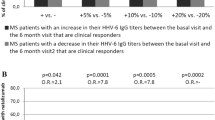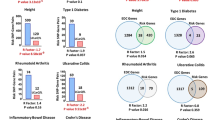Abstract
Multiple sclerosis (MS) is an autoimmune disease characterized by inflammatory neuronal damages and consequent disabilities. Episodic relapses of the disease which lead to brain lesions and irreversible neurological dysfunctions could be decreased by the interferon-beta (IFN-β) therapy in most of the MS patients. However, the efficiency of the drug response is highly variable among patients and the precise mechanism of action of the IFN-β is not clear. To investigate the role of RORA gene as a biomarker of patient’s responsiveness, the present study have analyzed the frequency of two polymorphisms (rs4774388 and rs11639084) within this gene between responder (n = 105) and nonresponder (n = 65) groups of MS patients in comparison with 200 healthy controls. The tetra primers-Amplification Refractory Mutation System-PCR method was used for genotyping. The obtained result of the current study showed a significant association between nonresponsiveness and the rs4774388 in dominant model (p = 0.03). However, the allele and genotype frequencies of rs11639084 were not different between controls, nonresponder, and responder patients. In addition, the frequencies of the estimated haplotype blocks were not different between examined groups. The obtained results of the present study suggested the rs4774388 as a possible effective factor in determination of response to IFN-β. However, further studies are needed to confirm the results in a larger sample size.
This is a preview of subscription content, access via your institution
Access options
Subscribe to this journal
Receive 6 print issues and online access
$259.00 per year
only $43.17 per issue
Buy this article
- Purchase on Springer Link
- Instant access to full article PDF
Prices may be subject to local taxes which are calculated during checkout
Similar content being viewed by others
References
Dendrou CA, Fugger L, Friese MA. Immunopathology of multiple sclerosis. Nat Rev Immunol. 2015;15:545.
Hamedani SY, Taheri M, Sajjadi E, Omrani MD, Mazdeh M, Arsang-Jang S, et al. Up regulation of MMP9 gene expression in female patients with multiple sclerosis. Human antibodies. 2016;24:59–64.
Eftekharian MM, Ghannad MS, Taheri M, Roshanaei G, Mazdeh M, Musavi M, et al. Frequency of viral infections and environmental factors in multiple sclerosis. Hum Antib. 2016;24:17–23.
Polman CH, Reingold SC, Banwell B, Clanet M, Cohen JA, Filippi M, et al. Diagnostic criteria for multiple sclerosis: 2010 revisions to the McDonald criteria. Ann Neurol. 2011;69:292–302.
Reder AT, Feng X. How type I interferons work in multiple sclerosis and other diseases: some unexpected mechanisms. J Interferon Cytokine Res. 2014;34:589–99.
Bertolotto A, Granieri L, Marnetto F, Valentino P, Sala A, Capobianco M, et al. Biological monitoring of IFN-β therapy in Multiple Sclerosis. Cytokine Growth Factor Rev. 2015;26:241–8.
Río J, Nos C, Tintoré M, Téllez N, Galán I, Pelayo R, et al. Defining the response to interferon‐β in relapsing‐remitting multiple sclerosis patients. Ann Neurol. 2006;59:344–52.
Weinstock-Guttman B, Badgett D, Patrick K, Hartrich L, Santos R, Hall D, et al. Genomic effects of IFN-β in multiple sclerosis patients. J Immunol. 2003;171:2694–702.
Connelly JF. Interferon beta for multiple sclerosis. Ann Pharmacother. 1994;28:610–6.
Eftekharian MM, Noroozi R, Sayad A, Sarrafzadeh S, Toghi M, Azimi T, et al. RAR-related orphan receptor A (RORA): a new susceptibility gene for multiple sclerosis. J Neurol Sci. 2016;369:259–62.
Yang XO, Pappu BP, Nurieva R, Akimzhanov A, Kang HS, Chung Y, et al. T helper 17 lineage differentiation is programmed by orphan nuclear receptors RORα and RORγ. Immunity. 2008;28:29–39.
Sayad A, Salmani T, Hemmesi MK, Ganji M, Ghafouri-Fard S, Hatami M, et al. Down-regulation of RORA gene expression in the blood of multiple sclerosis patients. Hum Antibodies. 2018;26:219–24.
Taheri M, Mirinezhad M, Omrani MD, Sajjadi E, Inoko H, Sayad A. Inverse relation between MxA gene expression and age in multiple sclerosis patients reveals a gender difference in response to interferon therapy. Iran J Allergy Asthma Immunol. 2017;16:21.
Mazdeh M, Taheri M, Sayad A, Bahram S, Omrani MD, Movafagh A, et al. HLA genes as modifiers of response to IFN-β-1a therapy in relapsing-remitting multiple sclerosis. Pharmacogenomics. 2016;17:489–98.
Sayad A, Ghafouri-Fard S, Omrani MD, Noroozi R, Taheri M. Myxovirus resistance protein A (MxA) polymorphism is associated with IFNbeta response in Iranian multiple sclerosis patients. Neurological Sci. 2017;38:1093–9.
Sayad A, Noroozi R, Omrani MD, Taheri M, Ghafouri-Fard S. Retinoic acid-related orphan receptor alpha (RORA) variants are associated with autism spectrum disorder. Metab Brain Dis. 2017;32:1595–601.
Taheri M, Omrani MD, Noroozi R, Ghafouri-Fard S, Sayad A. Retinoic acid-related orphan receptor alpha (RORA) variants and risk of breast cancer. Breast Dis. 2017;37:21–5.
Dean AG, Sullivan KM, Soe MM. OpenEpi: Open source epidemiologic statistics for public health, version. 2014.
Thompson AJ, Banwell BL, Barkhof F, Carroll WM, Coetzee T, Comi G, et al. Diagnosis of multiple sclerosis: 2017 revisions of the McDonald criteria. Lancet Neurol. 2017;17:162–73.
Miller D, Barkhof F, Berry I, Kappos L, Scotti G, Thompson A. Magnetic resonance imaging in monitoring the treatment of multiple sclerosis: concerted action guidelines. J Neurol Neurosurg Psychiatry. 1991;54:683–8.
Yoo J, Lee Y, Kim Y, Rha SY, Kim Y. SNPAnalyzer 2.0: a web-based integrated workbench for linkage disequilibrium analysis and association analysis. BMC Bioinform. 2008;9:290.
Coyle PK. Pharmacogenetic biomarkers to predict treatment response in multiple sclerosis: current and future perspectives. Mult Scler Int. 2017;2017:6198530.
O’Doherty C, Favorov A, Heggarty S, Graham C, Favorova O, Ochs M, et al. Genetic polymorphisms, their allele combinations and IFN-beta treatment response in Irish multiple sclerosis patients. Pharmacogenomics. 2009;10:1177–86.
Nguyen A, Rauch TA, Pfeifer GP, Hu VW. Global methylation profiling of lymphoblastoid cell lines reveals epigenetic contributions to autism spectrum disorders and a novel autism candidate gene, RORA, whose protein product is reduced in autistic brain. FASEB J. 2010;24:3036–51.
Lai Y-C, Kao C-F, Lu M-L, Chen H-C, Chen P-Y, Chen C-H, et al. Investigation of associations between NR1D1, RORA and RORB genes and bipolar disorder. PloS One. 2015;10:e0121245.
Silveira AC, Morrison MA, Ji F, Xu H, Reinecke JB, Adams SM, et al. Convergence of linkage, gene expression and association data demonstrates the influence of the RAR-related orphan receptor alpha (RORA) gene on neovascular AMD: a systems biology based approach. Vis Res. 2010;50:698–715.
Hennings J, Uhr M, Klengel T, Weber P, Pütz B, Touma C, et al. RNA expression profiling in depressed patients suggests retinoid-related orphan receptor alpha as a biomarker for antidepressant response. Transl Psychiatry. 2015;5:e538.
Acknowledgements
The current study was supported by a grant from Shahid Beheshti University of Medical Sciences.
Author information
Authors and Affiliations
Contributions
SAA supervised the study. SG-F contributed in data analysis and paper writing. RN performed the experiments and wrote the paper. MT designed and supervised the study.
Corresponding authors
Ethics declarations
Conflict of interest
The authors declare they have no conflict of interest.
Additional information
Publisher’s note Springer Nature remains neutral with regard to jurisdictional claims in published maps and institutional affiliations.
Rights and permissions
About this article
Cite this article
Ayatollahi, S.A., Ghafouri-Fard, S., Taheri, M. et al. The efficacy of interferon-beta therapy in multiple sclerosis patients: investigation of the RORA gene as a predictive biomarker. Pharmacogenomics J 20, 271–276 (2020). https://doi.org/10.1038/s41397-019-0114-0
Received:
Revised:
Accepted:
Published:
Issue Date:
DOI: https://doi.org/10.1038/s41397-019-0114-0
This article is cited by
-
Twenty Years of Subcutaneous Interferon-Beta-1a for Multiple Sclerosis: Contemporary Perspectives
Neurology and Therapy (2024)
-
Could NCOA5 a novel candidate gene for multiple sclerosis susceptibility?
Molecular Biology Reports (2023)
-
Genetic and molecular biology of autism spectrum disorder among Middle East population: a review
Human Genomics (2021)



